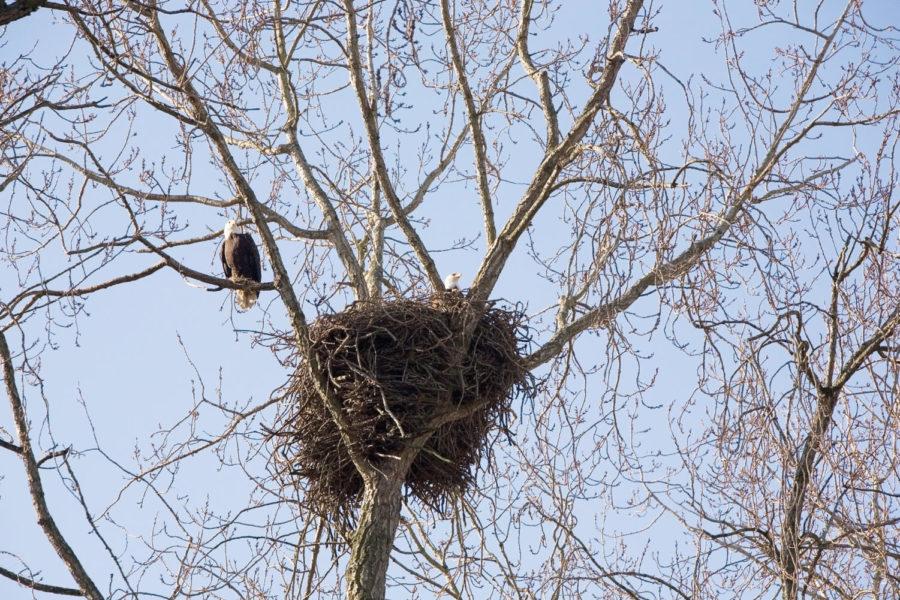Cline: Eagle camera takes flight again
March 21, 2012
Every small town is famous for something. Each community has its own unique source of notoriety and pride. For Decorah, Iowa, that celebrity is derived from a bald eagle’s nest. Situated among the bluffs of northeast Iowa, Decorah had mainly been known as the home of Luther College and a large population of Norwegians. In 2009, a camera was placed in an eagle’s nest and made the town of 8,000 a global phenomenon.
Started by the Raptor Resource Project and director Bob Anderson, the live-streaming camera has burgeoned into one of the most popular sensations on the Web. The Raptor Resource Project, which began in 1988, was designed “to preserve and strengthen raptor populations, expand participation in raptor preservation and help foster the next generation of preservationist,” as the organization’s website describes their mission.
The group took on the challenge of restoring and caring for the population of eagles, falcons and owls, among other bird species. While the current camera may be stealing the headlines, the organization’s first endeavor of that kind began in 1998. Titled “Mae’s Interest,” it was the first online bird cam, according to the Raptor Resource Project website.
Just more than a decade later, the Decorah Eagle Cam became the most-watched live video stream ever. The camera went from being a niche fad that barely stretched beyond northeast Iowa to a record-breaking viewership of more than 215 million people in 2011. Nearly 500,000 people have already tuned in to the nest since the camera was relaunched in mid-February.
As a Decorah native, it was easy to resent the camera’s popularity at first. I introduced myself as a Decorah local and all people wanted to talk about was the eagles. Never mind any of the other positive characteristics the area and community had to offer, the splendor of a small eagle camera superseded everything else. Type Decorah into any search engine and “Decorah eagles” is always the first term to pop up; drive by the area where the noted nest is located and throngs of people can be seen gazing up at the tree like Fourth of July fireworks.
Northeast Iowa is a haven for all species of wildlife. A wide range of birds, mammals and plants populate the bluffs and valleys. A tubing or canoeing trip down one of the regions many small rivers would likely yield multiple sightings of raptors, including bald eagles. Having grown up with the privilege of seeing bald eagles on a relatively regular basis, I spent a few hours of watching the camera to see how it compared, but I still was unsure why it was so popular.
While there may be a few enthralling moments, such as the eaglets taking their first flight or the parents returning to the nest with a fish plucked from a nearby stream, much of the action is more subdued and calm. Even now when the eggs are yet to hatch, thousands of people are streaming the camera at all hours. So why are people so mesmerized by the bald eagles camera?
Perhaps it is a reflection of our current urbanization and society’s desire to reconnect with nature. Fewer and fewer people have the opportunity to see a wide array of wildlife in their natural habitat. Urban areas may have crows, raccoons and rabbits, but fewer and fewer people can step onto their back porch and see a nice buck or slip away for an afternoon at a trout stream.
Estimated numbers of crow populations in Ames can surpass 15,000 birds, whereas bald eagles number approximately 10,000 breeding couples in the entire country. According to the U.S. Fish and Wildlife Service, these already small numbers are concentrated in areas like the Mississippi River Valley, with Minnesota and Wisconsin each having more than 1,000 pairs. A sight that could be easily taken for granted in rural Iowa is a rarity for many people outside of the concentrated regions. With the advent of the eagle camera, people across the globe can enjoy this aspect of wildlife in a whole new light.
The Raptor Resource Project is among the leaders in the new wave of education and exposure. Not only has the bald eagle camera soared to new heights of popularity, the group’s projects have been expanded so that fans can follow one of last year’s eaglets, “D1,” and the organization is talking about creating a new Decorah turkey vulture camera to join their existing network.
In a world of urbanization, hectic schedules and life always on the go, the eagle camera is a modern way for people to interact with nature. There is no editing or censorship; it is an unparalleled raw view of wildlife. The Decorah Bald Eagle camera is something in which the community and state can take pride.
Computers are at our fingertips seemingly every hour of every day, and thanks to technology such as the eagle camera, we are now able to get closer to nature, no matter how far away we may be.







